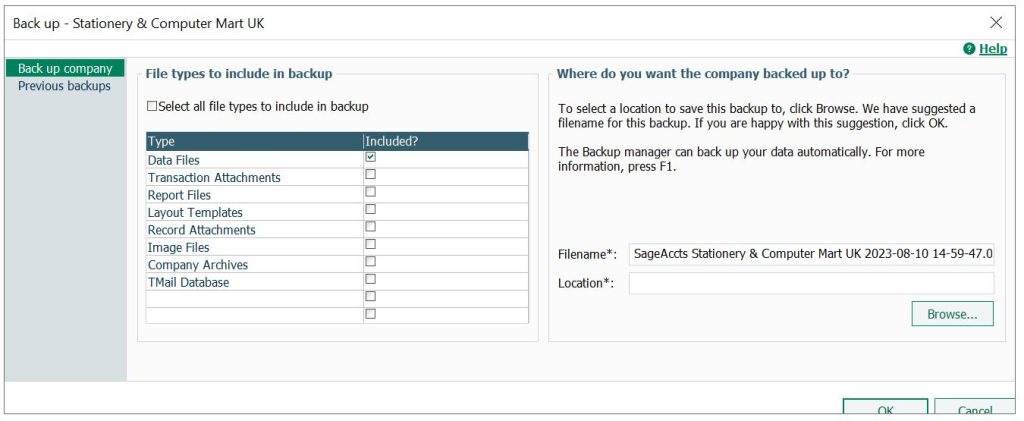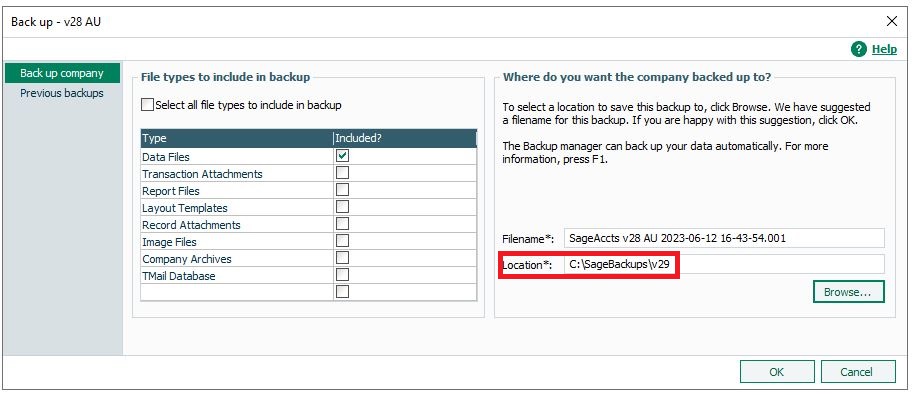Backing up Sage 50 data is a critical aspect of financial management for businesses and organizations using this software. This process involves creating copies of your financial and accounting data to ensure its protection and availability in case of data loss, hardware failure, or unforeseen disasters. Regularly backing up your Sage 50 data is essential to prevent financial disruptions and maintain data integrity.
The process typically includes selecting the data to back up, choosing a storage location (which can be local or cloud-based), and scheduling backups to occur at regular intervals. It’s also important to periodically test backups to ensure they can be successfully restored. Sage 50 provides features for creating and restoring backups, and understanding this process is essential for maintaining the security and continuity of financial operations.
Tips for Data Backup in Sage 50 Accounts
Data backup is crucial to protect your information from potential risks like hardware failures, cyberattacks, and natural disasters. It’s often the quickest and most cost-effective way to recover your data, and sometimes, it’s the only way.
Here are some best practices for data backup
- Utilize automatic backup features in your software (if available).
- Regularly test your backups by restoring and running the software.
- Avoid relying solely on cloud-based “incremental” backups, as they may not fully restore your data.
- Store backups in diverse locations, including external drives and USB sticks, with at least one off-site backup.
- Use offline external drives to safeguard against natural disasters and cyberattacks.
Additional tips to keep in mind
- Remote Data Access (RDA) companies for 50CA and 50US are not substitutes for backups.
- If you have an IT company handling your data backups, collaborate with them to conduct regular data restores and testing.
Common mistakes to avoid include
- Failing to set up regular backups.
- Overlooking built-in automatic backup features.
- Storing all backups in one location.
- Depending solely on incremental backups from services like Google Drive, OneDrive, or Dropbox.
- Assuming your IT service automatically backs up data without regular testing.
- Purchasing backup software but neglecting to set it up.
Remember, you are responsible for your backups. Always password-protect your data for added security.
How to Create a Backup of Your Data in Sage 50 Accounts?
Creating a backup of your Sage 50 Accounts data is a simple yet crucial process that should ideally be done daily for each company. It typically takes just a few minutes, although it may take longer if you have extensive data.
Here’s a step-by-step guide to creating a manual backup
- Open the desired company, go to the “File” menu, and select “Back up.”

- Take note of the suggested file name or modify it as needed.
- Click “Browse” to choose a location for saving the backup file and then click “OK.”
- If you want to include other files like reports and layouts in the backup, either select them from the list or choose “Select all file types.”
- Click “OK.” If prompted to check your data, click “Yes,” and then click “Close.”
- Confirm by clicking “OK“
Your company’s data is now successfully backed up, allowing you to restore it to this point at any time if the need arises.
Choose Backup Location
When selecting the backup location, remember that the software stores this information. In case you need to find a backup for restoration, you can browse the path displayed in your backup window.
Note: The default backup location is C:\SageBackups\vxx.

Automatic Backups
For added convenience and peace of mind, consider utilizing automatic backups, a time-saving feature that ensures your data is consistently secured.
If facing issues while backing up data, get steps to fix the Sage 50 data backup failure issue.
How to Create a Backup of Your Data in Sage 50 Payroll?
Creating a backup of your data in Sage 50 Payroll is a recommended practice to ensure the safety of your information. It’s best to store these backups outside your computer, like on a memory stick, so you can restore them in case of unexpected computer issues.
We advise making backups both before and after updating your payroll or making substantial changes to your records. To enhance data security, consider creating backups in multiple locations, such as on a USB drive and a server.
Here’s how to create a payroll backup
- From the menu bar, click on File and select Backup.

- Click Next, then choose the files you want to include in your backup.
- Click Next again, then click Browse to specify where you want to save the file.
- Rename the file to make it easily identifiable by date.
- Click Save, then click Next.
- Finally, click Finish and OK.
If your backup file is large, consider backing up specific files separately, particularly documents, as they can significantly contribute to the backup size. We recommend creating backups both before and after updating your payroll and before making significant changes to your records. For added security, consider backing up your data to multiple locations, such as a USB drive and a server. This redundancy can be invaluable in safeguarding your vital information.
Restoring a backup in Sage 50 Accounting U.S. Edition is a straightforward process
Ensure you’re using the correct backup before proceeding, as overwriting data with a backup is irreversible. If you need to restore from another backup, do so.
- Go to the “File” menu and select “Restore.”
- Click on “Browse” and choose the backup file you want to restore, then click “Open.”
- Select “Next.”
- Choose your restore method:
- “Overwrite existing company data” or “An Existing Company“
- “Create a new company using the restored data” or “A New Company“.
Note: Option for “A New Company” if you want to restore the backup to a new folder without overwriting existing data.
- Select “Next.”
- Specify your restore options, which may include:
- Company Data
- Customized Forms
- Web Transactions
- Intelligence Reporting Reports or Business Intelligence Reports
- Click “Next.”
- Review the restore options and select “Finish.”
- Once the restoration is complete, the company will open.
Facing issues while restoring a backup, check out the steps to fix the Sage 50 unable to create or restore a backup.
Note: If you need to change the company name because you restored to a new folder, go to “Maintain,” and then select “Company Information.”
Conclusion
In conclusion, backing up your Sage 50 data is a crucial practice to ensure the safety and availability of your financial records. It protects you from data loss due to various unforeseen events. Remember, regular backups and keeping them in secure, diverse locations are essential. If you encounter a backup unsuccessful in Sage 50 or need guidance in this process, don’t hesitate to reach out to our Sage 50 experts. They are here to assist you and provide peace of mind for your data management.
FAQ’s
Why is data backup important in Sage 50?
Data backup in Sage 50 is crucial to safeguard your financial records and ensure you can recover them in case of data loss, hardware failure, or other unforeseen issues.
How often should I back up my Sage 50 data?
It’s recommended to back up your data daily, especially if you frequently make transactions or updates. Regular backups minimize the risk of data loss.
Can I store Sage 50 backups in the cloud?
Yes, you can use cloud storage for Sage 50 backups, but it’s essential to ensure that your cloud service complies with data security standards and that backups are easily accessible.
What’s the difference between full and incremental backups in Sage 50?
A full backup copies all data, while an incremental backup only saves changes made since the last backup. Full backups are more comprehensive, but incremental backups are quicker.
Is there a way to manually locate a backup in Sage 50 if it can’t be found automatically?
Yes, if an error-free backup can’t be found automatically then click on “Browse” to locate it manually. Double-click on the backup you want to restore. If you’re uncertain then restore each backup and check the data until you find one without errors.

